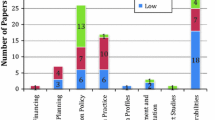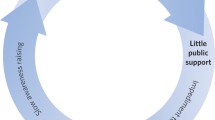Abstract
Considerable barriers can emerge in developing and implementing climate change adaptation strategies. Understanding the nature of barriers to adaptation is important so as to find strategic ways of dealing with them. However, our current understanding is limited and highly fragmented across the academic community. This paper aims to bring some conceptual convergence in these debates by applying a systematic review method to assess the current state of knowledge on barriers to adaptation in the peer-reviewed literature. The review results show that: (1) Barriers to adaptation have hardly been defined in the literature and no clear indicators exist so as to identify and assess them systematically. (2) An impressive number of barriers have been reported, but the list of possible barriers is seemingly endless. (3) The most frequently reported barriers relate to the institutional and social dimensions of adaptation. (4) Barriers are identified as configurations of climate and non-climate factors and conditions that emerge from the actor, the governance system, or the system of concern. (5) Barriers are mainly studied in developed countries with a strong focus on water-related domains. (6) The majority of studies on barriers use small-n inductive case approaches while comparative studies across different contexts are limited. (7) Although interventions to overcome barriers are recommended by most studies, empirical studies on interventions are scarce. We present further conceptual clarification and a more precise definition of barriers to adaptation. We conclude that future research should go beyond asking the questions ‘if’ and ‘which’ barriers to adaptation exist and begin asking ‘how’ and ‘why’ barriers emerge.




Similar content being viewed by others
Notes
‘Adjustment in natural or human systems in response to actual or expected climatic stimuli or their effects, which moderates harm or exploits beneficial opportunities. Various types of adaptation can be distinguished, including anticipatory, autonomous and planned adaptation’ (IPCC 2007, p. 869).
References
Adger WN (2000) Institutional adaptation to environmental risk under the transition in Vietnam. Ann Assoc Am Geogr 90:738–758
Adger WN, Barnett J (2009) Four reasons for concern about adaptation to climate change. Environ Plan A 41:2800–2805
Adger WN, Arnell NW, Tompkins EL (2005) Successful adaptation to climate change across scales. Glob Environ Change 15:77–86
Adger WN, Agrawala S, Mirza MMQ, Conde C, O’Brien K, Pulhin J, Pulwarty R, Smit B, Takahashi K (2007) Assessment of adaptation practices, options, constraints and capacity. Climate change 2007: impacts, adaptation and vulnerability. In: Parry ML, Canziani OF, Palutikof JP, van der Linden PJ, Hanson CE (eds) Contribution of Working Group II to the fourth assessment report of the intergovernmental panel on climate change. Cambridge University Press, Cambridge, pp 717–743
Adger WN, Dessai S, Goulden M, Hulme M, Lorenzoni I, Nelson DR, Naess LO, Wolf J, Wreford A (2009a) Are there social limits to adaptation to climate change? Clim Change 93:335–354
Adger WN, Lorenzoni I, O’Brien K (eds) (2009b) Adapting to climate change: thresholds, values and governance. Cambridge University Press, Cambridge
Amundsen H, Berglund F, Westskogh H (2010) Overcoming barriers to climate change adaptation-a question of multilevel governance? Environ Plan C 28:276–289
Barnett J (2010) Adapting to climate change: three key challenges for research and policy—an editorial essay. Wiley Interdiscip Rev Clim Change 1:314–317
Barnett J, O’Neill S (2010) Maladaptation. Glob Environ Change 20:211–213
Berrang-Ford L, Ford JD, Paterson J (2011) Are we adapting to climate change? Glob Environ Change 21:25–33
Biesbroek GR, Swart RJ, Carter TR, Cowan C, Henrichs T, Mela H, Morecroft MD, Rey D (2010) Europe adapts to climate change: comparing national adaptation strategies. Glob Environ Change 20:440–450
Boer H (2010) Policy options for, and constraints on, effective adaptation for rivers and wetlands in northeast Queensland. Aust J Environ Manag 17:154–164
Brown RR, Farrelly MA (2009) Delivering sustainable urban water management: a review of the hurdles we face. Water Sci Technol 59:839–846
Bunce M, Brown K, Rosendo S (2010) Policy misfits, climate change and cross-scale vulnerability in coastal Africa: how development projects undermine resilience. Environ Sci Policy 13:485–497
Burch S (2010a) In pursuit of resilient, low carbon communities: an examination of barriers to action in three Canadian cities. Energy Policy 38:7575–7585
Burch S (2010b) Transforming barriers into enablers of action on climate change: insights from three municipal case studies in British Columbia, Canada. Glob Environ Change 20:287–297
Checkland K, Harrison S, Marshall M (2007) Is the metaphor of ‘barriers to change’ useful in understanding implementation? Evidence from general medical practice. J Health Serv Res Policy 12:95–100
Crabbé P, Robin M (2006) Institutional adaptation of water resource infrastructures to climate change in, Eastern Ontario. Clim Change 78:103–133
Doria MdF, Boyd E, Tompkins EL, Adger WN (2009) Using expert elicitation to define successful adaptation to climate change. Environ Sci Policy 12:810–819
Dovers SR, Hezri AA (2010) Institutions and policy processes: the means to the ends of adaptation. Wiley Interdiscip Rev Clim Change 1:212–231
Dupuis J, Biesbroek GR (2012) The dependent variable problem in comparing and evaluating climate change adaptation policies in Western European Countries. Second Nordic International Conference on climate change adaptation, Helsinki, Finland
Eisenack K, Stecker R (2012) A framework for analyzing climate change adaptations as actions. Mitig Adapt Strateg Glob Change 17:243–260
Ekstrom JA, Moser SC, Torn M (2011) Barriers to adaptation: a diagnostic framework. Final Project Report for the California Energy Commission, Sacramento, CA
Eriksen S, Lind J (2009) Adaptation as a political process: adjusting to drought and conflict in Kenya’s Drylands. Environ Manag 43:817–835
Esbjörn-Hargens S (2010) An ontology of climate change integral pluralism and the enactment of multiple objects. J Integral Theory Pract 5:143–174
Falagas ME, Pitsouni EI, Malietzis GA, Pappas G (2008) Comparison of PubMed, Scopus, Web of Science, and Google Scholar: strengths and weaknesses. FASEB J 22:338–342
Falaleeva M, O’Mahony C, Gray S, Desmond M, Gault J, Cummins V (2011) Towards climate adaptation and coastal governance in Ireland: integrated architecture for effective management? Marine Policy 35:784–793
Ford JD, Pearce T (2010) What we know, do not know, and need to know about climate change vulnerability in the western Canadian Arctic: a systematic literature review. Environ Res Lett 5(1):014008. doi:10.1088/1748-9326/5/1/014008
Ford JD, Berrang-Ford L, King M, Furgal C (2010a) Vulnerability of aboriginal health systems in Canada to climate change. Glob Enviro Change 20:668–680
Ford JD, Keskitalo ECH, Smith T, Pearce T, Berrang-Ford L, Duerden F, Smit B (2010b) Case study and analogue methodologies in climate change vulnerability research. Wiley Interdiscip Rev Clim Change 1:374–392
Ford JD, Berrang-Ford L, Paterson J (2011) A systematic review of observed climate change adaptation in developed nations. Clim Change 106:327–336
Fünfgeld H (2010) Institutional challenges to climate risk management in cities. Curr Opin Environ Sustain 2:156–160
Gifford R, Kormos C, McIntyre A (2011) Behavioral dimensions of climate change: drivers, responses, barriers, and interventions. Wiley Interdiscip Rev Clim Change 2:801–827
Glaas E, Jonsson A, Hjerpe M, Andersson-Sköld Y (2010) Managing climate change vulnerabilities: formal institutions and knowledge use as determinants of adaptive capacity at the local level in Sweden. Local Environ 15:525–539
Goggin ML (1986) The “Too Few Cases/Too Many Variables” problem in implementation research. West Polit Q 39:328–347
Hamlet AF (2010) Assessing water resources adaptive capacity to climate change impacts in the Pacific Northwest Region of North America. Hydrol Earth Syst Sci Discuss 7:4437–4471
Head L (2010) Cultural ecology: adaptation—retrofitting a concept? Prog Hum Geogr 34:234–242
Huang C, Vaneckova P, Wang X, Fitzgerald G, Guo Y, Tong S (2011) Constraints and barriers to public health adaptation to climate change: a review of the literature. Am J Prev Med 40:183–190
IPCC (ed) (2007) Climate change 2007: impacts, adaptation and vulnerability. Cambridge University Press, Cambridge, p 976
Jantarasami LC, Lawler JJ, Thomas CW (2010) Institutional barriers to climate change adaptation in U.S. National Parks and Forests. Ecol Soc 15:33
Jasanoff S (2010) A new climate for society. Theory Cult Soc 27:233–253
Jones L, Boyd E (2011) Exploring social barriers to adaptation: insights from Western Nepal. Glob Environ Change 21:1262–1274
Lesnikowski AC, Ford JD, Berrang-Ford L, Paterson JA, Barrera M, Heymann SJ (2011) Adapting to health impacts of climate change: a study of UNFCCC Annex I parties. Environ Res Lett 6:044009
Lebel L, Manuta JB, Garden P (2011) Institutional traps and vulnerability to changes in climate and flood regimes in Thailand. Reg Environ Change 11(1):45–58
Marsh D, McConnell A (2010) Towards a framework for establishing policy success. Public Adm 88:564–583
McConnell A (2010) Policy success, policy failure and grey areas in-between. J Public Policy 30:345–362
McNeeley SM (2012) Examining barriers and opportunities for sustainable adaptation to climate change in interior Alaska. Clim Change 111:835–857
Measham T, Preston B, Smith T, Brooke C, Gorddard R, Withycombe G, Morrison C (2011) Adapting to climate change through local municipal planning: barriers and challenges. Mitig Adapt Strateg Glob Change 16:889–909
Moser SC (2010) Now more than ever: the need for more societally relevant research on vulnerability and adaptation to climate change. Appl Geogr 30:464–474
Moser SC, Ekstrom JA (2010) A framework to diagnose barriers to climate change adaptation. Proc Natl Acad Sci 107:22026–22031
Mozumder P, Flugman E, Randhir T (2011) Adaptation behavior in the face of global climate change: survey responses from experts and decision makers serving the Florida Keys. Ocean Coast Manag 54:37–44
Næss LO, Bang G, Eriksen S, Vevatne J (2005) Institutional adaptation to climate change: flood responses at the municipal level in Norway. Glob Environ Change 15:125–138
Nielsen JØ, Reenberg A (2010) Cultural barriers to climate change adaptation: a case study from Northern Burkina Faso. Glob Environ Change 20:142–152
O’Brien K, Hochachka G (2010) Integral adaptation to climate change. J Integral Theory Pract 5:89–102
O’Brien K (2009) Do values subjectively define the limits to climate change adaptation? In: Adger WN, Lorenzoni I, O’Brien K (eds) Adapting to climate change: thresholds, values, governance. Cambridge University Press, Cambridge, pp 164–180
O’Brien K, Eriksen S, Sygna L, Naess LO (2006) Questioning complacency: climate change impacts, vulnerability, and adaptation in Norway. Ambio 35:50–56
O’Brien K, Eriksen S, Nygaard LP, Schjolden A (2007) Why different interpretations of vulnerability matter in climate change discourses. Clim Policy 7:73–88
O’Toole LJJ (1986) Policy recommendations for multi-actor implementation: an assessment of the field. J Public Policy 6:181–210
Petticrew M, Roberts H (2006) Systematic reviews in the social sciences: a practical guide. Blackwell Publishing, Malden
Rijke J, Brown R, Zevenbergen C, Ashley R, Farrelly M, Morison P, van Herk S (2012) Fit-for-purpose governance: a framework to make adaptive governance operational. Environ Sci Policy 22:73–84
Smit B, Wandel J (2006) Adaptation, adaptive capacity and vulnerability. Glob Environ Change 16:282–292
Storbjörk S (2010) ‘It takes more to get a ship to change course’: barriers for organizational learning and local climate adaptation in Sweden. J Environ Plan Policy Manag 12:235–254
Storbjörk S, Hedrén J (2011) Institutional capacity-building for targeting sea-level rise in the climate adaptation of Swedish coastal zone management. Lessons from Coastby. Ocean Coast Manag 54:265–273
Sutton SG, Tobin RC (2011) Constraints on community engagement with Great Barrier Reef climate change reduction and mitigation. Glob Environ Change 21:894–905
Tompkins EL, Adger WN, Boyd E, Nicholson-Cole S, Weatherhead K, Arnell N (2010) Observed adaptation to climate change: UK evidence of transition to a well-adapting society. Glob Environ Change 20:627–635
Tryhorn LM, Lynch AH (2010) Climate change adaptation in the Alpine Shire of Australia: a decision process appraisal. Policy Sci 43:105–127
Acknowledgments
This work is supported by the Dutch national ‘Climate changes Spatial Planning’ research programme and the Strategic Knowledge Development Programme of Wageningen UR on Climate Change (Kennisbasis 2 thema Klimaatverandering). We would like to thank Alexandra Lesnikowski and the two anonymous reviewers for their helpful comments and suggestions. The views expressed in this article are those of the authors.
Author information
Authors and Affiliations
Corresponding author
Electronic supplementary material
Below is the link to the electronic supplementary material.
Rights and permissions
About this article
Cite this article
Biesbroek, G.R., Klostermann, J.E.M., Termeer, C.J.A.M. et al. On the nature of barriers to climate change adaptation. Reg Environ Change 13, 1119–1129 (2013). https://doi.org/10.1007/s10113-013-0421-y
Received:
Accepted:
Published:
Issue Date:
DOI: https://doi.org/10.1007/s10113-013-0421-y




